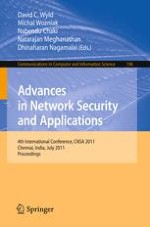2011 | Book
Advances in Network Security and Applications
4th International Conference, CNSA 2011, Chennai, India, July 15-17, 2011
Editors: David C. Wyld, Michal Wozniak, Nabendu Chaki, Natarajan Meghanathan, Dhinaharan Nagamalai
Publisher: Springer Berlin Heidelberg
Book Series : Communications in Computer and Information Science
